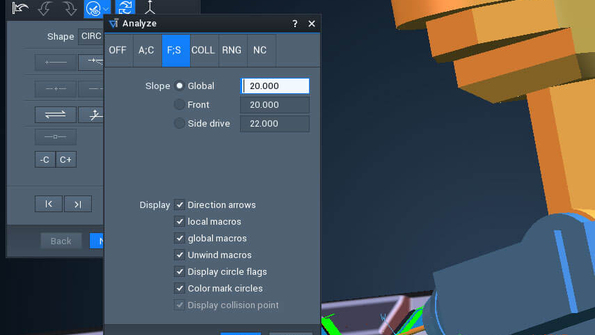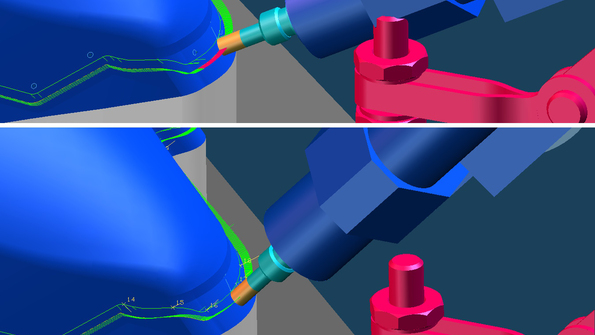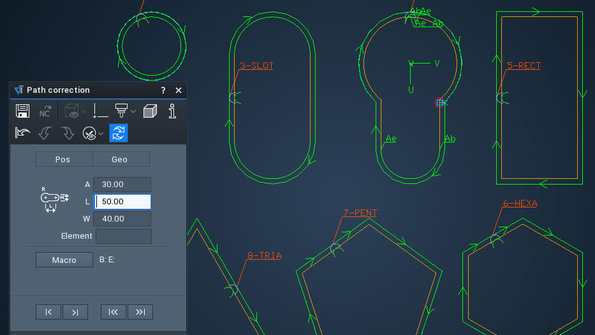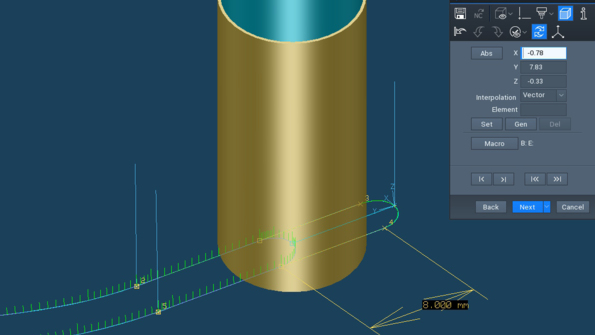-
Software
-
CAM software
- Tebis Automill
- CNC programming
- CNC automation
- CNC simulator
- Multiple setup
- Robotic machining
- CNC drilling
- Deep-hole drilling
- Combined turn-milling
- CNC turning
- Turn-milling
- 2.5D milling
- 3D milling
- 5-axis milling
- Slot milling
- Trimming
- HPC milling
- HFC milling
- Circle-segment cutters
- Sinker EDM
- Wire EDM
- 3D laser cutting
- Laser hardening
- Laser weld cladding
- CAD software
- CAQ software
- MES software
- Products
- Stories about parts
-
CAM software
- Services
- Consulting
- Sectors
- References
- Company
- News

-

Trimming
Greater productivity through offline programming
Tebis helps you master the challenges in 5-axis trimming: You can quickly and reliably create toolpaths for trimming your parts – perpendicular to the part surface or parallel to a flank – even for complex geometries. Collisions with other part areas, clamping devices or machine components are not possible. Offline programming lets you avoid tedious teach-in and unproductive use of the machine. This applies to both vacuum-formed parts made out of thermoplastic materials and to parts made out of composite materials (e.g. carbon) as well as to parts clad with wood and with other natural materials.
EfficientQuickly and reliably produce collision-free CNC programsReliableDetect and correct all problem areas before the program goes to the 5-axis machineFastShort cycle times in trimming on the machineHigh qualityHigh quality of the cut partsVideo
View video / contact formPlease select the Preference cookies to activate the display.Activate cookies5-axis trimmingTrimming with TebisThis video shows trimming on an aluminum/plastic composite part for a center console. A collision-checked CNC program for series production is generated with just a few clicks. This requires that the tool tilt angle be changed within a tight space, while the angle of the cut flank must still fulfill all functional and design requirements.
Functions
Simultaneously automated and flexible

Tebis automatically calculates results for 5-axis trimming that you can change interactively and at any time. You can flexibly adjust the starting position and the spatial position of the machine head, just like the areas to be trimmed and their machining sequence. This lets you integrate your own manufacturing expertise in the programming. You can also easily handle deviations between CAD data and the actual part (distortion, etc.).
Analyzes for quality and efficiency

Tebis supports you with many analysis functions during interactive programming for trimming. You always retain an overview of the rotation angle and area, tool tilt direction and collisions. This makes it easy to optimize the machine's 5-axis rotation movements for fast and smooth trimming. You can also adapt your manufacturing projects to the axis angle limitations and unavoidable unwind movements of the machine.
No lost time due to collisions

Because Tebis models all your manufacturing resources for trimming as digital twins, you have a continuous overview of the entire machine situation. This means that you never fail to catch any collision between the tool, spindle or head and the part, clamping devices, or other machine components. Tebis prevents many collisions with automatic interpolation. The collision analysis is always updated on all interactive changes in the toolpaths. All machining operations are therefore safely planned on the 5-axis machines. Lost time and money due to collisions during trimming are a thing of the past.
Quickly achieve your goals with form elements

Standard form elements lie holes, slots, rectangles, triangles, pentagons and hexagons and keyholes are automatically detected in trimming. Your benefit: These geometry standards are exported as subprograms to the NC program. This enables the control and 5-axis machine to work in a more targeted and efficient manner.
Adapt existing machining operations for trimming

Your machining operations are saved with adjustments and individual settings in Tebis NCJob management for subsequent adaptation to changed requirements. You can use transformation functions to quickly and easily generate NC programs from these for trim machining of workpieces with mirrored symmetry. The machine's kinematic limits are continuously monitored.
If you already have trimming programs from the past for which there are no CAD/CAM data, you still have options with Tebis. In just a few steps, reverse processors can transform the NC data back into NCJobs that can be used for a different machine or adapted to new requirements.
For everyone who wants to learn more
Webinars, technical articles, interviews ...
View video / contact formPlease select the Preference cookies to activate the display.Activate cookiesIn this webinar, you will learn how a vacuum clamping fixture made of Ureol is designed and parametrically linked to the component data. We will then show how the fixture is manufactured quickly and safely using digital twins.View video / contact formPlease select the Preference cookies to activate the display.Activate cookiesBased on a practical example, a CFRP wing shell measuring approx. 2000 x 2500 mm, you will learn in this webinar, how to trim CFRP components using the right combination of CAD/CAM strategies, machine and tool.








